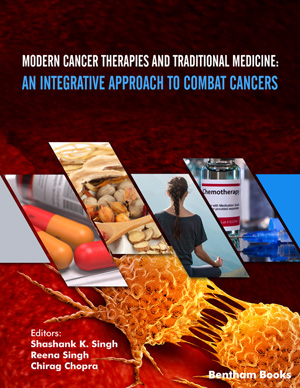
摘要
三阴性乳腺癌代表多种基因组和转录组异质性。 TNBC 中出现的遗传和表观遗传变化有助于它获得对免疫反应的抵抗力。远处转移、缺乏临床靶向治疗和预后标志物使其成为最具侵袭性的乳腺癌形式。在这篇综述中,我们发现靶向基因 AR、ERR、TIL、TAM、miRNA、mTOR 和免疫抑制细胞因子的驱动改变主要通过诱导细胞增殖、侵袭和转移以及抑制细胞凋亡参与了 TNBC 的并发症。还研究了淋巴结状态、组织蛋白酶-D、Ki-67 指数、CD3+TIL、BRCA1 启动子甲基化值和 p53 作为有效预后因素的作用,以预测 TNBC 患者的无病生存率和总生存率。本综述文章试图以新的视角了解 TNBC 的病因、治疗策略和预后标志物,以确定标准治疗的结果,并重新设计未来的治疗策略,为患者提供最大的益处。
关键词: AR、microRNAs、TAM、TNBC、TILs、治疗、预后。
图形摘要
[http://dx.doi.org/10.1177/1758834012444711] [PMID: 22754593]
[http://dx.doi.org/10.1309/AJCPQN8GZ8SILKGN] [PMID: 24619745]
[http://dx.doi.org/10.1172/JCI45014] [PMID: 21633166]
[http://dx.doi.org/10.1158/1535-7163.MCT-14-0926] [PMID: 25713333]
[http://dx.doi.org/10.1177/1758834012475152] [PMID: 23634195]
[http://dx.doi.org/10.2174/1389201021666200627201535] [PMID: 32593278]
[http://dx.doi.org/10.3390/cells9112358] [PMID: 33114740]
[http://dx.doi.org/10.1186/1746-6148-9-80] [PMID: 23587222]
[http://dx.doi.org/10.1038/srep31804]
[http://dx.doi.org/10.4048/jbc.2017.20.1.65] [PMID: 28382096]
[http://dx.doi.org/10.1111/cas.13644] [PMID: 29777630]
[http://dx.doi.org/10.4137/CIN.S9983] [PMID: 22872785]
[http://dx.doi.org/10.1158/1078-0432.CCR-09-1091] [PMID: 20068102]
[http://dx.doi.org/10.1016/S1470-2045(10)70018-8] [PMID: 20189874]
[PMID: 19933920]
[http://dx.doi.org/10.1158/0008-5472.CAN-06-0031] [PMID: 16651414]
[http://dx.doi.org/10.1177/000313480507100906] [PMID: 16468506]
[http://dx.doi.org/10.1186/bcr2635] [PMID: 20813035]
[http://dx.doi.org/10.1158/1078-0432.CCR-07-4379] [PMID: 18593979]
[http://dx.doi.org/10.1038/nm972] [PMID: 14702632]
[http://dx.doi.org/10.1038/sj.onc.1208561] [PMID: 15897907]
[PMID: 27058032]
[http://dx.doi.org/10.1093/annonc/mdw067] [PMID: 27052658]
[http://dx.doi.org/10.1159/000443052] [PMID: 26938985]
[http://dx.doi.org/10.1530/ERC-16-0068] [PMID: 26932782]
[http://dx.doi.org/10.1038/nrc3239] [PMID: 22437870]
[http://dx.doi.org/10.1074/jbc.M115.702571] [PMID: 26792858]
[http://dx.doi.org/10.12659/MSM.895386] [PMID: 26752006]
[http://dx.doi.org/10.1007/s13277-015-4710-6] [PMID: 26749280]
[http://dx.doi.org/10.1158/0008-5472.CAN-15-2321] [PMID: 26676753]
[http://dx.doi.org/10.18632/oncotarget.6961] [PMID: 26799586]
[http://dx.doi.org/10.3892/or.2016.4767] [PMID: 27108696]
[http://dx.doi.org/10.18632/oncotarget.7276] [PMID: 26871469]
[http://dx.doi.org/10.1038/nature02924] [PMID: 15329734]
[http://dx.doi.org/10.1126/science.274.5288.784]
[http://dx.doi.org/10.1186/bcr3575]
[http://dx.doi.org/10.1007/978-1-4020-5133-3_24]
[http://dx.doi.org/10.1186/bcr3640]
[http://dx.doi.org/10.1186/bcr3634] [PMID: 24684785]
[http://dx.doi.org/10.1186/bcr3391] [PMID: 23448424]
[http://dx.doi.org/10.1200/JCO.2008.21.3033] [PMID: 19687332]
[http://dx.doi.org/10.1158/1535-7163.MCT-12-0466] [PMID: 23270925]
[http://dx.doi.org/10.1016/j.canlet.2016.04.002] [PMID: 27060208]
[http://dx.doi.org/10.1111/jcmm.15683] [PMID: 32725802]
[http://dx.doi.org/10.1371/journal.pone.0083081] [PMID: 24340082]
[http://dx.doi.org/10.1186/bcr1636] [PMID: 17217540]
[http://dx.doi.org/10.1158/1078-0432.CCR-05-2281] [PMID: 16533778]
[http://dx.doi.org/10.1038/modpathol.2008.72] [PMID: 18469794]
[PMID: 3491673]
[PMID: 2785562]
[http://dx.doi.org/10.7243/2049-7962-3-2] [PMID: 25177489]
[http://dx.doi.org/10.1093/jjco/hyp007] [PMID: 19304743]
























